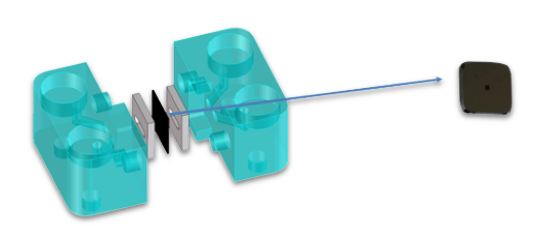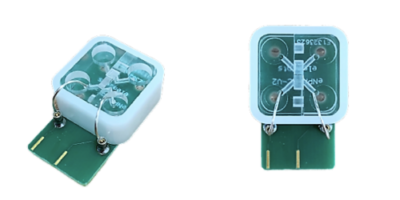Artificial solid-state nanopores are nanosized pores fabricated in insulating membranes. By monitoring ion currents and forces as molecules pass through a solid-state nanopore, it is possible to investigate a wide range of phenomena involving DNA, RNA and proteins.
Nanopore Reader: Solid state nanopores
Solid-State Nanopore Flowcell


The nanopore containing chip fits in a 5×5 mm² cavity and is secured with silicone rubber gaskets. Both chambers are accessible and can be filled with low volumes (10 μl – 60 μl of electrolyte solution). The nanopore chip can be rapidly changed without tools and the flow cell is reusable.
User cases

dsDNA fragment translocation data obtained with a 17-nm-diameter SiN x pore at +200 mV, 1M KCl (10 mM Tris buffer, 1 mM EDTA and pH 8.0) for (a) 15 kbp, (b) 1000 bp, and (c) 400 bp dsDNA, and corresponding event duration histograms measured at 100 kHz bandwidth.
Red curves are exponential fits to obtain the characteristic dwell times.
Modified from Niedzwiecki et al Rev Sci Instrum. 2020 Mar 1;91(3):031301
 Exemplary current trace of 200 and 350 nm sized polystyrene nanoparticles translocating trough a laser drilled Polymide-made 1µm pore. The signal was sampled at 20 kHz SR by applying + 600 mV of bias voltage. Two distinct population are visible, corresponding to the 200 and 350 nm sized particles.
Exemplary current trace of 200 and 350 nm sized polystyrene nanoparticles translocating trough a laser drilled Polymide-made 1µm pore. The signal was sampled at 20 kHz SR by applying + 600 mV of bias voltage. Two distinct population are visible, corresponding to the 200 and 350 nm sized particles.
-Elements srl
- Reusable Flow cell
- Flowcell materials: Standard PMMA, Delrin, or Teflon
- Nanopore Chip not included
- Chip cavity size: 4×4 or 5×5 mm
- Chip thickness*: 200-500 µm
- 0,5 mm diameter electrode wire
*By choosing the proper gasket with the appropriate thickness (thicker Chip needs thinner gaskets), you can place nanopore chips of any thickness in this flow cell.
- Detection of single analyte and environmental samples with silicon nitride nanopores: Antarctic dirt particulates and DNA in artificial seawater, AIP Review of Scientific Instruments
- DNA fragment translocation in artificial sea water through nanopores using a portable mini reader and flow-cell, poster presented during the 63rd Biophysical Meeting

Custom solutions
Let us know how we can help you design the tools and software you need.

